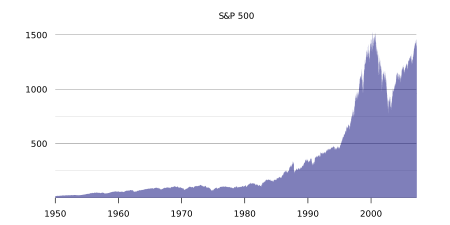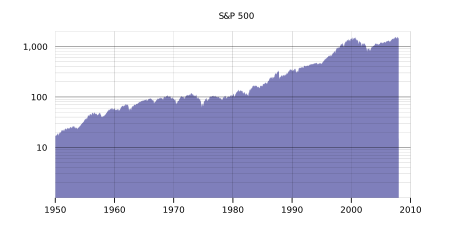|
S&P
500 Index
The S&P 500 is a stock market index containing
the stocks of 500 Large-Cap corporations, most of which
are American. The index is the most notable of the many
indices owned and maintained by Standard & Poor's, a
division of McGraw-Hill. S&P 500 is used in reference
not only to the index but also to the 500 actual companies,
the stocks of which are included in the index.
The
S&P 500 index forms part of the broader S&P 1500
and S&P Global 1200 stock market indices.
|
|
|
All of the stocks
in the index are those of large publicly held companies and trade
on the two largest US stock markets, the New York Stock Exchange and Nasdaq. After the Dow Jones Industrial Average, the S&P 500 is the most
widely watched index of large-cap US stocks. It is considered to
be a bellwether for the US economy and is a component of the Index
of Leading Indicators. It is often quoted using the symbol SPX or
INX, and may be prefixed with a caret (^) or with a dollar sign
($).Many
index funds and exchange-traded funds track the performance of the
S&P 500 by holding the same stocks as the index, in the same
proportions, and thus attempting to match its performance (before
fees and expenses). Partly because of this, a company which has
its stock added to the list may see a boost in its stock price as
the managers of the mutual funds must purchase that company's stock
in order to match the funds' composition to that of the S&P
500 index.
In stock and
mutual fund performance charts, the S&P 500 index is often
used as a baseline for comparison. The chart will show the S&P
500 index, with the performance of the target stock or fund overlaid.
History

Linear
graph of the S&P 500 from 1950 to the present

Logarithmic
graph of the S&P 500 index from 1950 to the present
The S&P
500 index was created in 1957, but it has been extrapolated back
in time. The first S&P index was introduced in 1923. Prior
to 1957, the primary S&P stock market index consisted of 90
companies, known as the "S&P 90", and was published on a daily
basis. A broader index of 423 companies was also published weekly.
On March 4, 1957, a broad, real-time stock market index, the S&P
500 was introduced. This introduction was made possible by advancements
in the computer industry which allowed the index to be calculated
and disseminated in real time. (See Detailed Timeline.)
The S&P
500 is used widely as an indicator of the broader market, as it
includes both "growth" stocks (which inflated and then deflated
in the dot-com bubble and bust) and generally less volatile "value"
stocks; it also includes stocks from both the NASDAQ stock market
and the NYSE. The index, near the height of the bubble, reached
an all-time intraday high of 1,552.87 in trading on March 24,
2000, and then lost approximately 50% of its value in a two-year
bear market, spiking below 800 points in July 2002 and reaching
a low of 768.63 intraday on October 10, 2002. Since then, the
US stock markets gradually recovered, but the S&P 500 lagged
the popular Dow Jones Industrial Average and total-market Wilshire
5000 indices by remaining below its highs of 2000 for a longer
period. On May 30, 2007, the S&P 500 closed at 1,530.23 to
set its first all-time closing high in more than seven years.
On July 13, 2007, the index followed a nearly thirty-point gain
the previous day by setting a new intra-day record of 1,555.10
points, its first of the 21st century.
Selection
The components
of the S&P 500 are selected by committee. This is similar
to the Dow 30, but different from others such as the Russell 1000,
which are strictly rules-based.
The index
does include a handful (13 as of July 6, 2007) of non-U.S. companies.
This group includes both formerly American companies that are
now incorporated outside of the United States, but which were
grandfathered and allowed to remain in the S&P 500 after their
expatriation, and companies that have never been incorporated
in the United States. Notably, after the merger of Daimler-Benz
and Chrysler, the S&P did not include the newly created German
aktiengesellschaft (company) in the index.
The committee
selects the companies in the S&P 500 so they are representative
of various industries in the United States economy. In addition,
companies that do not trade publicly (such as those that are privately
or mutually held) and stocks that do not have sufficient liquidity
are not in the index - a notable example of an illiquid stock
not in the index is Berkshire Hathaway, which as of April 3, 2006
had a market capitalization larger than all but 12 of the members
of the S&P 500, but which also had a stock price (in the case
of its class A shares) greater than $100,000, and so was very
difficult to trade. By contrast, the Fortune 500 attempts to list
the 500 largest public companies in the United States by gross
revenue, regardless of whether their stocks trade or their liquidity,
without adjustment for industry representation, and excluding
companies incorporated outside the United States.
Weighting
The index
was market-value weighted; that is, movements in price
of companies whose total market valuation (share price times the
number of outstanding shares) is larger will have a greater effect
on the index than companies whose market valuation is smaller.
The index
has since been converted to float weighted; that is, only
shares which Standard & Poors determines are available for
public trading ("float") are counted. The transition was made
in two tranches, the first on March 18, 2005 and the second on
September 16, 2005. (For example, only the Class A shares of Google
("GOOG") are publicly traded; thus, of the 207,096,000 total shares
outstanding as of March 2006, only the 199,570,000 Class A shares
were considered float, so only the value of the latter number
of shares was used to incorporate Google into the S&P 500
on March 31, 2006.) Only a minority of companies in the index
have this sort of public float lower than their total capitalization;
for most companies in the index S&P considers all shares to
be part of the public float and thus the capitalization used in
the index calculation equals the market capitaliation for those
companies.
Investing
Apart from
purchasing the individual stocks in the S&P 500, investors
may also purchase shares of an exchange-traded fund (ETF) which
represents ownership in a portfolio of the equity securities that
comprise the Standard & Poor's 500 Index. One of these ETF's
is called the Standard & Poor's Depositary Receipts (SPDRs,
pronounced "spiders"), and the ticker symbol is SPY. Typical volume
for the SPDR is over 200 million shares per day the highest of
any US stock. There is also the iShares S&P 500 (Symbol:IVV),
which is similar to the SPDRs, but is structured differently.
Rydex also offers an ETF, Rydex S&P Equal Weight (Symbol:RSP),
which provides equal exposure to all the companies in the S&P
500.
The relatively
compact units of these ETFs represent an opportunity for the smaller
investor to achieve a performance close to the S&P 500 Index
(minus fees and expenses). They trade like any other stock on
the American Stock Exchange, so they can be
bought on margin, sold short, or held for the long term. Both
the SPDRs and the iShares have a management expense ratio of under
0.1% a year, making them an efficient proxy for the underlying
index.
Several mutual
fund managers also provide index funds that track the S&P
500, the first of which was The Vanguard Group's (fund: VFINX)
.
Additionally,
the Chicago Mercantile Exchange (CME) offers
futures and options on the S&P 500 index. S&P futures
can be traded on the exchange floor in an open outcry auction,
or on CME's Globex platform, though only E-mini contracts are
traded on Globex during regular trading hours.
Annual
Total Returns
Total returns
including reinvested dividends, in percent:
| Year |
Annual Return |
| 1994 |
1.32 |
| 1995 |
37.58 |
| 1996 |
22.96 |
| 1997 |
33.36 |
| 1998 |
28.58 |
| 1999 |
21.04 |
| 2000 |
-9.11 |
| 2001 |
-11.89 |
| 2002 |
-22.10 |
| 2003 |
28.68 |
| 2004 |
10.88 |
| 2005 |
4.91 |
| 2006 |
15.80 |
| 2007 |
5.49 |
External
links
|

